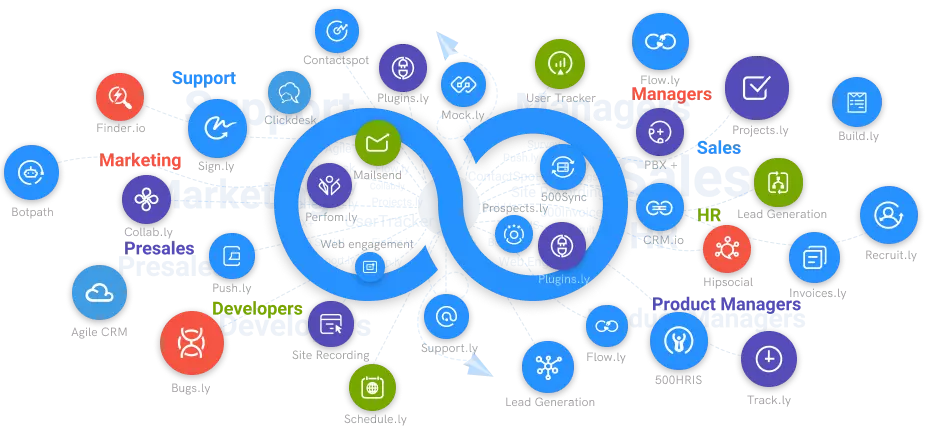What is a Ticketing System?
Get to know about a ticketing system, how it works and its importance in customer support.
#1
Manage all your support tickets in one place
#2
Provide multi-channel support via email, chat, call, knowledge base and social media
#3
Create automation rules for faster resolutions and routing
#4
Get a 360-degree view of customer data with CRM integrations
#5
Enable self-support for your customers through brandable knowledge base
#6
Organize tickets and follow-up on them using built-in task management
#7
Integrate with built-in NinjaChat (live-chat software) and BotUp (AI Chatbot)
#8
Generate customer service reports to identify areas of improvement
#9
Unbelievable pricing - the lowest you will ever find
#10
Everything your business needs - 50 apps, 24/5 support and 99.95% uptime
A ticketing system is a software application that allows users to submit support requests, called tickets, for customer service and technical support. Tickets are typically categorized by the severity of the issue and the department that has responsibility for resolving it.
There are a few different types of ticketing systems out there. Some track all incoming incidents while others only track urgent ones. An incident can be anything from a problem with a computer app to a faulty product. The most common type of ticketing system is known as a ticket-management or tracking system where the IT staff assigns tickets to other staff members who have been trained in their specific discipline or skill set, such as programming or design.
A ticketing system ticketing system is an application that allows you to keep track of the conversations with your customers. This system consists of three key components:
- Ticketing function
- Document management
- CRM integration
A ticketing system lets you record requests made by your customers, assigning them to the appropriate customer service team member for resolution. It also allows users to view requests and other information about their interactions with the company.
How Does a Ticketing System Work?
A ticketing system records the interactions on a support or service case by first creating a document, or ticket.The ticket is shared by both the rep and the customer, and it keeps track of their interactions in one place. Both parties can refer back to the thread at any time to check previous material on the issue if there is any confusion or if a detail is missed.
Reps can then work on the issue on their end after the ticket has been created. They can notify the customer via the ticket when they have updates or a resolution. In the meanwhile, if the consumer has any questions, they can use the ticket to contact the customer support representative. The ticketing system then notifies the rep that a response has been logged on the ticket, allowing the rep to address it right away.
When the issue has been fixed, the ticket can be closed by either the salesperson or the consumer. If either party has any additional follow-up questions or requests, the tickets can be reopened. Instead of having to open a new ticket with a different representative, the customer can contact the same person with whom they previously worked and pick up where they left off. Some ticketing systems also have built-in customer feedback features, such as Net Promoter Score (NPS), that collect consumer input whenever a ticket is closed.
Different Stages of Ticketing System
New – A new ticket is created.
Open – A support representative will investigate the ticket and take the appropriate action. The agent may, for example, allocate the ticket to another operator.
In-progress – The agent is working on resolving the issue.
Solved – The problem has been addressed.
Closed – After the customer has been updated and all steps have been done, the ticket is closed.
Importance of Ticketing System
A ticketing system is a customer care tool that aids in the management of service and support cases for businesses. The helpdesk software generates a ticket that tracks client requests and interactions over time, making it easier for customer support representatives to resolve complex situations.
A ticketing system assists customer support staff in prioritising their tasks so that they may provide a better customer experience.
The more clients who interact with your business, the more customer support and service cases you will receive. Unless you hire more customer care representatives to meet the increased demand, your team will be under more pressure to multi-task and answer problems at the same time. Adding a ticketing system to your help desk is a terrific approach to get through this stumbling block because it gives your customer support personnel scalable alternatives.
Some of the primary reasons why developing businesses should consider implementing a ticketing system for their customer care and support teams are listed below.
Organization: A ticketing system's most evident value is its capacity to organise and categorise a large number of support cases for a complete customer care department. Because each ticket is identified and may be prioritised by its urgency, reps can easily manage many cases at once. This is useful in emergency scenarios if consumers are submitting a huge number of support and service tickets for a single issue. A ticketing system aids in the identification and segmentation of these cases so that they can be addressed in bulk by a designated task force.
Communication: A helpdesk ticketing system would assist your team combine communication into one thread if your organisation provides omnichannel support experience. Customers can reach out to your customer service staff through a variety of communication channels with omnichannel support. Customers may not always use the same channel when troubleshooting a certain support or service issue, which is a disadvantage. They might start by tweeting at your team, then call for an update, and then want you to follow up with an email. This can make communication extremely difficult, especially for sales representatives who deal with more than 20 consumers per day. Ticketing systems solve this problem by consolidating all communication onto a single thread. The encounter is always logged to the same area, regardless of which channel the consumer uses to contact you.
Accessibility: Ticketing systems make it easy for both the customer and the customer service representative to communicate with one another because communication is limited to one single location. Customers can instantly access a ticket from their email inbox and send inquiries straight to the customer service representative who is working on their issue. Customers feel more empowered since they have a direct line to their customer service representative rather than a generic help mailbox. The salesperson also benefits from the accessibility element because it relieves pressure on them to settle situations fast. Customers don't have access to agents' personal email addresses, so they may work at their own leisure without being interrupted by eager customers.
Conclusion
A ticketing system aids companies in delivering an integrated and seamless response by providing a variety of capture techniques, the capacity to control progress, and the ability to keep stakeholders informed. If you believe your internal system is growing increasingly chaotic, it's time to adopt an IT ticketing system. By consolidating all service inquiries into a single help desk, you'll be able to save even more time.





